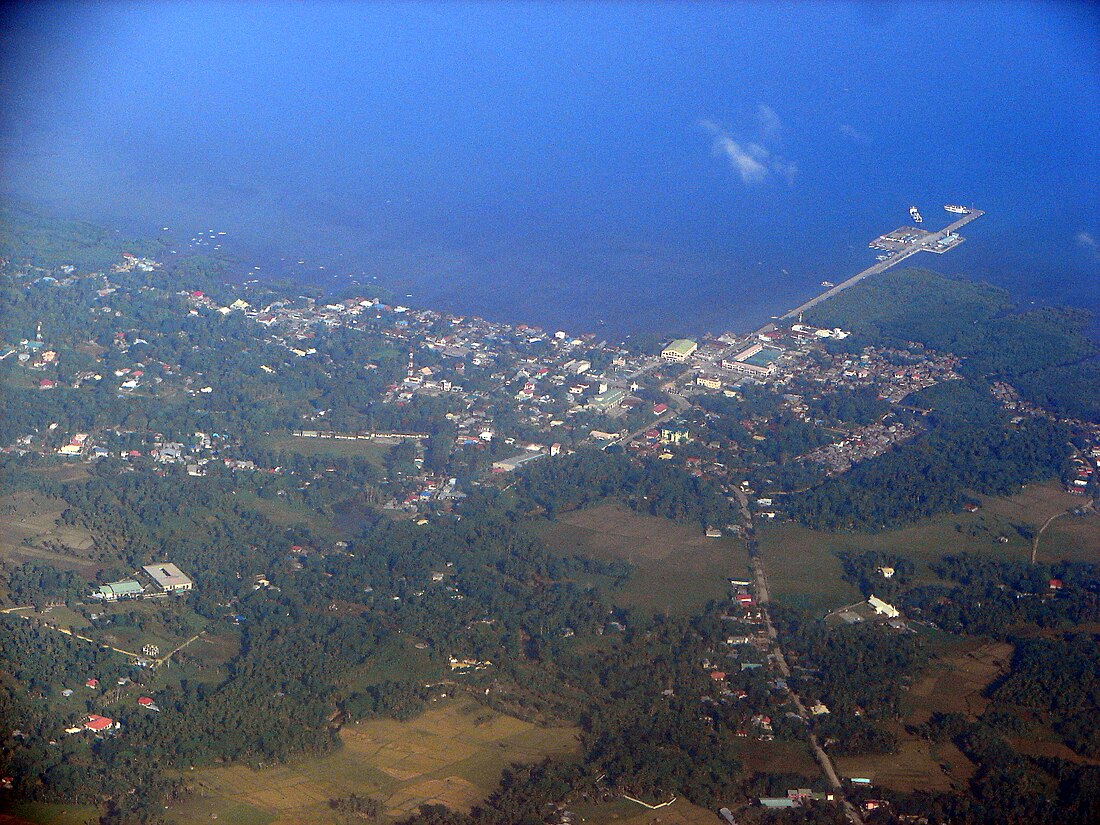Top Qs
Timeline
Chat
Perspective
Tubigon
Municipality in Bohol, Philippines From Wikipedia, the free encyclopedia
Remove ads
Tubigon, officially the Municipality of Tubigon (Cebuano: Lungsod sa Tubigon; Tagalog: Bayan ng Tubigon), is a municipality in the province of Bohol, Philippines. According to the 2024 census, it has a population of 49,275 people.[6]
Tubigon is well known for its "lambay" crabs.[7]
The municipality of Tubigon, Bohol celebrates its feast on May 15, to honor the town patron San Isidro Labrador.[8]
Remove ads
History
Summarize
Perspective
The first settlers in Tubigon settled along the shores of the river that flows through the community. Their exact origins are unknown but they are thought to be early Malays from southeast Asian countries, migrating to the Philippines in small bangkas. Seasonal overflowing of the river flooded the community and led the place to be called "Tubigan" (meaning "place having water" or "watery"), which later morphed into "Tubigon" (meaning "place abounding in water"). The first record of the town of Tubigon dates from the early part of the 17th century.[9][10]
In 1816, the community organized itself under a recognized headman, Yguiz Hutora, who was succeeded by teniente Mijares and by teniente Matong in 1818. A chapel was built on an elevated site of the settlement but had no officiating priest. A coadjutor of the Spanish friars from the Calape parish would perform the religious ceremonies.[9]
In 1819, by authority of the Spanish governor of Cebu, Tubigon was formally organized into an independent town by separating from the town of Calape, with Capitan Teniente Matong becoming the first gobernadorcillo.[9]
Starting in 1852, the exact boundaries of the municipality were defined. On 8 March of that year, sitio Bacane was made the boundary between Tubigon and Inabanga. In 1856, the boundary with Calape was fixed at Mandaug. On 19 June 1865, the boundary between Tubigon and Catigbian was set at the Sampilangon River and on 14 September 1913, the boundary with Antequera (currently San Isidro) was fixed at sitio Tubod.[9]
On 31 January 1919, Tubigon lost five barrios when Clarin was formed by virtue of proclamation by Governor Yeater.[9][11]
Tubigon was badly affected by the 2013 Bohol earthquake, suffering 11 fatalities and damage to some 7,300 homes, as well as total destruction of its town hall and church.[12]
Remove ads
Geography
Summarize
Perspective

Tubigon is bounded by Calape in the west, Clarin in the east, by the Cebu Strait in the north, and San Isidro in the south. Located 54 kilometres (34 mi) from Tagbilaran, it is the nearest seaport in Bohol to Cebu City, providing many daily ferry round-trips to Cebu City. It has recently expanded its seaport to accommodate additional sea traffic.[13]
Barangays
Tubigon is politically subdivided into 34 barangays. Each barangay consists of puroks and some have sitios.
Islands
There about 17 minor islands in the municipal, some of whom are inhabited:
- Bagongbanwa
- Batasan
- Bilangbilangan
- Budlaan
- Cabgan
- Cancostino
- Danajon Reef (part)
- Hayaan
- Inanuran
- Maagpit
- Mocaboc
- Pangapasan
- Sib
- Silo
- Taboan Islet
- Tanga‑on
- Ubay Island and Reef
Climate
Remove ads
Demographics
Economy
Poverty incidence of Tubigon
10
20
30
40
50
2000
37.94
37.94
2003
21.21
21.21
2006
41.50
41.50
2009
37.36
37.36
2012
26.69
26.69
2015
21.48
21.48
2018
16.30
16.30
2021
23.35
23.35
Source: Philippine Statistics Authority[21][22][23][24][25][26][27][28]
Agriculture and fishing are the primary industries. 60% of the total land area of the municipality is used by agriculture and other related industries. The main agricultural produce includes rice, corn, coconut, bananas and different variety of vegetables.[29]
Electric power is supplied by the Bohol Electric Cooperative I (BOHECO I). Its new administrative building is located in Tubigon along the National Road.
Remove ads
Tourism
Enchanted Ilijan Hill Volcanic Nature Park
On April 15, 2024, first placer, Tubigon was awarded P25 million by the Department of Tourism's Tourism Champions Challenge, for the five-year development of Poblacion's Enchanted Ilijan Hill Volcanic Nature Park. Ilijan Hill was certified by PHIVOLCS as a volcanic plug, the Philippines’ first. As a prime tourist attraction with biodiversity and nature conservation, it showcases along the Plug Heritage Zone, a visitor center, a view deck, the Ilijan Heritage Center, Tubigon Arts and Culture Village and garden trail.[30]
Remove ads
Transportation
- Road
The main National Road is paved and provides easy access to neighboring coastal communities, with travel time to Tagbilaran about one hour. There are inland roads to Catigbian and San Isidro.
Public utility buses are available daily on routes to any point within the province of Bohol. Trips to Tagbilaran are on a 30-minute interval. Cars and vans are available for rent or charter any time.
- Boat and ferry
Tubigon's municipal port is the second largest and busiest port in the province of Bohol. It is served by 6 conventional vessels and 2 modern fastcraft with a total of 20 trips daily to Cebu City. A roll-on/roll-off ferry operated by Lite Shipping Corporation is also operational making two trips daily.[29]
There is no scheduled ferry service to smaller outlying islands, but outrigger canoes may be chartered any time.
Remove ads
Gallery
- Municipal hall (pre-earthquake)...
- ...and after
- Poblacion
- Cultural Center
- Market and Commercial Center
Notable personalities
- Amay Bisaya, actor and comedian[31][32]
- Pauline Amelinckx, Miss Supranational 2023 first runner-up
References
External links
Wikiwand - on
Seamless Wikipedia browsing. On steroids.
Remove ads










